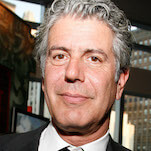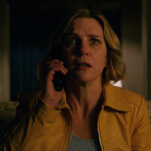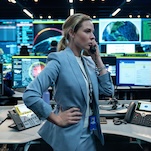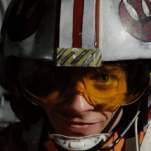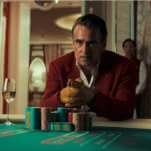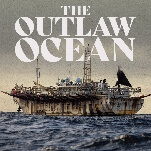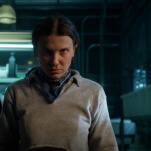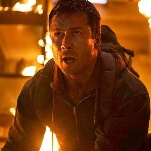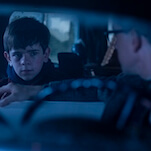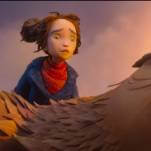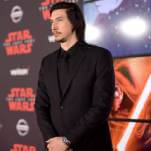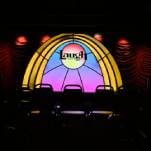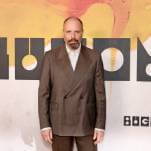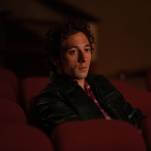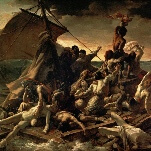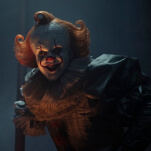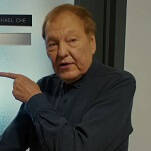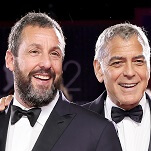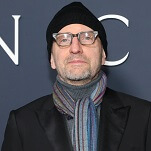Whatever metaphor I use for genres is serving that idea. In the course of talking about genres recently, I did start to think that the idea of genres as toolkits, which I’d been using before, wasn’t really right. It’s not so much that you come up with a story and think, “Okay, I need to stick in a vampire here,” or “This should have a spaceship.” That’s not how storytelling should work, per se. It’s more like a skin. You start with the outermost layer, what it’s going to look like, then you kind of get deeper into it. What’s actually going on beneath the surface is not really dictated by or related to the surface genre. It’s more about what’s going to happen between the characters and what’s taking place in the story.
It’s something I think about as a reader as well. I’m reading a novel right now [Wake Of Vultures by Lila Bowen] that’s sort of a supernatural Western with lots of different monsters, like vampires and werewolves, in the Wild West. It’s really entertaining and does some interesting things with the Western tropes. There’s a lot of stuff happening between the characters that, by and large, could happen in any genre. But the way you view it is partly shaped by the fact that it is a supernatural Western instead of a post-apocalyptic story or something. Those are the sort of things I think about as a writer and as a reader.
The Sorcerer Of The Wildeeps by Kai Ashante Wilson
CJA: The thing that’s interesting about this book is that it’s your Fritz Leiber-esque, fantasy story about these mercenaries, swords for hire, who are escorting people across this magical wasteland. It’s got a lot of the sword-and-sorcery tropes in there, then suddenly they’ll start talking about faster-than-light travel. This is kind of a spoiler, but you start to realize that this is actually some kind of far-future scenario, similar to Jack Vance or Gene Wolfe. It’s futuristic, but it still has all of the sword-and-sorcery stuff. And there is magic, either the way Arthur C. Clarke sees it in his Third Law, “Any sufficiently advanced technology is indistinguishable from magic,” or because things have just gotten weird and they’ve discovered magic in some way. The whole thing is interesting both as a future, weird-science story and as a magical adventure. It works on both levels, which is really fun.
AVC: It seems inevitable that Clarke’s Third Law will come up in any conversation about mixing science fiction and fantasy. That statement has become a cliché, but do you think it still has power?
CJA: Now versus when Clarke was writing, people really don’t understand the technology they’re using. It’s been talked about a lot. Apple products in particular are designed in such a way that’s harder to get in and understand what processes are going on. Back a few decades ago, if you had a piece of technology, anyone could theoretically take it apart and put it back together again, and understand how it works. Some people would do that with the technology that they owned. It’s not as easy to do that today. Most users wouldn’t even think to do anything like that. I think that technology is much more mysterious to the people using it than, say, the automobile was. This isn’t an original observation, but a lot of the smart devices people rely on now really do feel like magic to a lot of us.
At the same time, I think there’s been a greater awareness among people, especially geeks, that the laws of physics don’t allow that much wiggle room in terms of things like faster-than-light travel, time travel, sending people to other planets. It’s harder than we were aware a few decades ago. I think there used to be this widespread imagination, this idea that we’d eventually just hop in a rocket and go to Mars. Now there’s more of an awareness of how hard our big science-fiction ideas are to implement in real life. On the one hand, technology is more mysterious. On the other hand, we’re more aware of its limitations. Every time I watch Star Trek, I’m highly aware of magical everything is: the holodeck, the warp drive. It’s possible that with wormholes we might eventually be able to do something like that. But the laws of physics are pretty unforgiving.
AVC: You mentioned smart devices, and there’s a fictional kind of device called a Caddy that figures prominently into All The Birds In The Sky. Was that your way of addressing some of these issues?
CJA: Yeah. It was something that just came up kind of naturally while I was writing the book. It felt right to have an object that talks about our dependence on technology, and to get into how we relate to the technology we use. And how it changes the way we see ourselves as people.
Brown Girl In The Ring by Nalo Hopkinson
CJA: I haven’t read this book in years, but it had a huge impact on me. It takes place in a near-future setting that’s dystopian, where Toronto has become not a very nice place to live. There are futuristic drugs and organ transplants and a lot of speculation about future political conditions that are horrifying. At the same time there’s all of this Caribbean magic. At one point, the villain is trying to create a duppy. There’s a lot of stuff in there from Caribbean traditions that’s super vivid. The genius of that novel is how effortlessly these two very different things go hand in hand: the dystopian future and the magic realism. They each make the other more intense and more exciting.
AVC: It’s an intriguing dynamic, too, considering that science fiction loves to explain how all the weird stuff works, while magic realism prefers not to.
CJA: The near-future stuff in the book is pretty plausible. It really does seem like an extension of what’s happening today. It feels really grounded that way, really connected to something real, which is part of why it resonates so much.
Perdido Street Station by China Miéville
CJA: This was the one book on my list of five that I felt would be a consensus pick, the one where a lot of people would probably talk about when discussing the mix of science fiction and fantasy. Perdido Street Station, like Brown Girl In The Ring, is something that I read a while ago, so it’s not as fresh in my mind as Sorcerer Of The Wildeeps. One thing that really stands out in my memory is the fact that I can’t say for sure what’s science and what’s magic in Perdido Street Station. It seems like it could have a scientific explanation, like all the stuff about thaumaturgy.
In a way—and this is me spitballing a little bit—it’s almost like alchemy. It’s kind of a science, but it’s also kind of not real. Obviously, people like Isaac Newton were alchemists. Alchemy and science existed side by side for a long time. A lot of the stuff in Perdido Street Station feels very scientific, but it’s probably not explainable by any real science. There’s also stuff that feels magical but could be scientific. I have no idea what’s actually going on at the end of the book with Mr. Motley and what he’s doing to people. Part of what makes that book so intense and skin-crawling is that you’re never entirely sure what the explanation is for a lot of what’s going on.
AVC: It’s almost like he’s taking the entire premise that science fiction and fantasy are different things and rejecting it entirely.
CJA: I think that’s accurate. I think he’s saying, “How about we just don’t worry about that?” But he also spends a lot of time explaining things like thaumaturgy and getting into the mechanics of how some of these weird things work. It’s genre-defying in that sense. He’s definitely treating science fiction and fantasy with defiance. [Laughs.] Which is great.
AVC: Do you think science fiction and fantasy learned something from that book since it came out in 2000?
CJA: I think so. A lot of writers have been influenced by Miéville generally, and Perdido Street Station is one of the books that people bring up a lot. It’s a book that casts a big shadow. Still, it remains sort of sui generis. Some of the stuff he does with politics and world-building is incredibly unique. There’s nothing else like it out there.
The Steel Remains by Richard K. Morgan
CJA: Here’s another book where I’m never actually sure what’s science and what’s magic. I really loved this one. I was blown away by the sense of people who had been through a lot of wars in the past, and they’re kind of scarred and bloodied. They have a lot of trauma, and now they’re facing this new, even more horrible threat. I think it’s definitely supposed to be some kind of future Earth. There are aliens, but there’s something really recognizable about the world. There’s something strange and beautiful about all these weird creatures that become a part of it.
There’s this whole tradition in genre fiction of this far-future or post-apocalyptic Earth that turns into a sword-and-sorcery, and I think Morgan is playing with that in The Steel Remains. He creates a world that feels very lived in, that has a lot of history, a deep past that its inhabitants are very aware of. It almost doesn’t matter if the creatures are aliens or magical beings.
AVC: There are certain science fiction and fantasy archetypes he’s superimposing, too.
CJA: Yeah. When I was giving that talk I mentioned earlier, about genres working for you rather than you working for genres, that subject came up. Elves are like aliens, and dragons are like dinosaurs. They’re not exactly the same, but once you start smushing genres together, you quickly find that a lot of the big fantasy archetypes have analogues in science fiction and vice versa. When you start throwing them together, the contrasts aren’t as bright as you might have thought them to be.
AVC: Do you think Morgan is subverting science fiction and fantasy or just reconfiguring them?
CJA: One of the big things that was revolutionary about The Steel Remains when it came out—or at least the thing that struck a lot of people and made a lot of waves—was how much explicit sexuality, especially LGBT sexuality, it contained. There’s a lot of queer sexuality to the book. I think that made a big impression on people. Without trying to read his mind, I think he was trying to push the envelope, what people expect from epic fantasy, in various ways.
I almost included George R.R. Martin’s A Song Of Ice And Fire on this list. Like The Steel Remains, A Song Of Ice And Fire is set in this incredibly violent world where there’s clearly magic. But at the same time, Westeros seems like a world that was on the verge of an enlightenment. The scientific method was starting to take hold, and people like Tyrion were rationalists and empiricists. But they’re pulled back into the Dark Ages because all of this magical, horrible stuff comes back. That’s a different approach than what I think Morgan is doing, but I think it’s interesting to contrast them.
Oscar And Lucinda by Peter Carey
CJA: This book had a huge impact on me. I’ve never seen the movie. I don’t have a big issue, like, “The movie can’t be as good as the book” or anything like that. It’s just that I have such a vivid impression of the book in my mind, I never want anything to supplant or change that. The influence of Oscar And Lucinda is all over All The Birds In The Sky in various ways. It’s one of those books where I read it and said, “Wow, I wish I could write like this.” I still wish I could write like that. It’s something that I still envy tremendously. Peter Carey is an incredible writer.
The thing about Oscar And Lucinda is, it’s not a genre book. There’s nothing in it that isn’t explainable through realism. There’s nothing in it that’s speculative. But at the same time, it is a book in which science is incredibly important. Also, there is a lot of magic realism happening on the edges. I guess Carey’s previous book, Illywhacker, had more magic realism. But there’s a lot of stuff in Oscar And Lucinda that feels like a magic trick. The whole final part of the book, with the glass church going up the river, feels very magical and very much like a fairy tale. And all the stuff about gambling, and things happening by chance, and the nature of games of chance, feels very magical to me.
Another thing that made the book so fascinating to me was all the ways he worked in the Victorians’ obsession with naturalism. The Victorian quest to understand the natural world is at the heart of the book. It’s a much more subtle combination of magic and science than some of the other books on my list. It’s just beautiful and unpredictable.
AVC: Carey once described Oscar And Lucinda as “a science fiction of the past.”
CJA: Oh! I did not know that. That’s interesting. One of the things that we always say at io9—and that Annalee [Newitz, io9 founder] and I have talked about a lot—is that if it’s fiction about science, then it’s science fiction. People always debate about what’s science fiction and what isn’t. Even when the movie Gravity with Sandra Bullock came out, some people were claiming that it wasn’t science fiction. Oscar And Lucinda is clearly fiction about science, and it’s clearly about the scientific method and the scientific worldview. But it’s also a very otherworldly book. You could imagine it taking place on another planet very easily.
